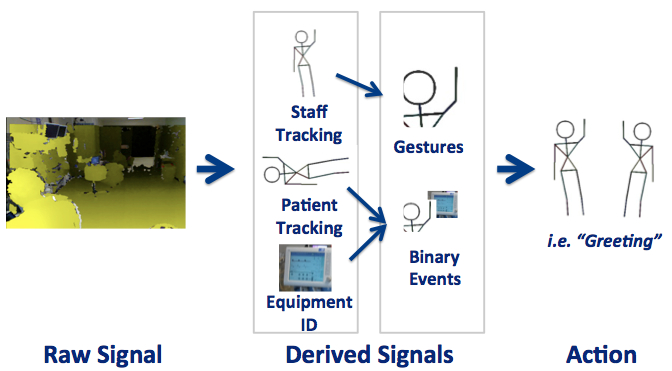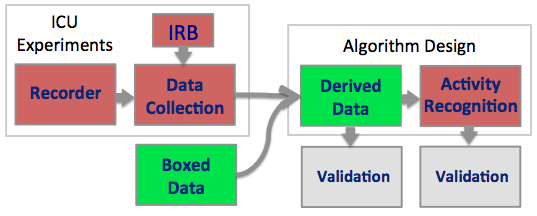Contact Us
CiiS Lab
Johns Hopkins University
112 Hackerman Hall
3400 N. Charles Street
Baltimore, MD 21218
Directions
Lab Director
Russell Taylor
127 Hackerman Hall
rht@jhu.edu
— clea1 2012/05/10 4:52
Our goal is to develop algorithmic tools for analyzing clinical workflow to identify directions for improving provider efficiency in an Intensive Care Unit. We believe that this may also lead to improved patient safety. The plan is to outfit a Pediatric ICU patient room with Xbox Kinects to gather video and 3D data to monitor the patient-staff and staff-device interactions. The focus over the course of this semester is to identify the actions that appear most frequently and to create a retrospective activity monitor to automatically log their occurrences. We will use a two-tiered approach for generating derived “low-level” signals and “high-level” activities that we believe will be adequate for workflow analysis.
If you talk to most staff at a hospital’s Intensive Care Unit (ICU) you will get the same story. Process is inefficient, everyone is very busy, and there is a lack of written direction. For every patient there are many hundreds of tasks that need to be completed by a team of up to fifteen staff members. These include actions like giving patients medication, emptying chest tubes, and documenting vital signs on a regular basis. By talking with doctors and nurses at the pediatric ICU it has become apparent that vision-based activity monitoring may help determine tasks being performed and provide insight into making the ICU a safer and more efficient workplace.
Activity monitoring in video has been prevalent in computer vision over the past twenty years and is becoming an even greater area of interest. The recent advent of inexpensive 3D imaging systems like the Xbox Kinect brings a new dimension of data without relying on complex multi-view camera networks. Currently, with a few notable exceptions most activity recognition research is done working with 2D images or is done to classify out-of-context actions – that aren’t representative of the real world – in a 3D framework. Our approach extends activity research using a dataset that has a cluttered environment and includes complex actions.
The overarching goal is to determine a high level understanding of patient and staff interactions. Three key questions are as follows:
Data Collection Data will be collected at the pediactric ICU at JHMI using two Xbox Kinects. Figure 1 depicts the approximate location of the equipment. Green circle/triangles represent the Kinects and the gray squares in the corners represent the computers used to record the data.
 Figure 1 Equipment layout in ICU room
Figure 1 Equipment layout in ICU room
A preliminary set of data will be recorded over a period of a few hours at the start of the project. The data will be hand annotated to assess the types of actions being performed and their frequency. Additional datasets will be recorded later in the semester on an as-needed basis.
Activity Recognition The activity recognition approach we take consists of a pipeline that inputs a raw signal from the Kinect, creates “derived signals,” and outputs an action label. This is depicted in the following figure.
 Figure 2 Activity Recognition Pipeline
Figure 2 Activity Recognition Pipeline
Raw signal consists of the data collected using our recorder and includes video, depth images, and potentially Kinect skeletons. From this data we will derive more useful signals such as the locations of the staff. Each derived signal requires implementing an algorithm to take the raw data and return a more usable result. Each signal will be developed as a “module” that we can plug into our system. Additional activity recognition modules will be developed that use whatever signals are available as inputs.
Potential modules:
There are four key components to this project, as shown in the following figure. Tasks with a green circle are considered “minimum” deliverables, yellow stars are “expected” and black diamonds are the “maximum.” The final deliverable for each part is either a set of code for each module or a set of data for the experiments. A final report will also be written documenting the project.
 Figure 3. Task breakdown
Figure 3. Task breakdown
The following graph depicts the primary dependencies for each part of the project. Additional dependencies are listed below. The red blocks in the graph are current unresolved dependencies and the green blocks are resolved dependencies.
In order to do data collection at the ICU we must have IRB approval and a data recorder. Currently I have multiple data recorders for extracting depth and video or the Kinect skeleton but not one robust system for doing both. This needs to be completed before full experiments can be run.
Note that we don’t need to run experiments in the ICU to perform the recognition tasks. Using data available freely online through a CVPR competition as well as data I have collected on my own we can run our derived data and activity recognition algorithms. Currently there is one set of derived signals from a gesture analysis algorithm I developed, thus, for example, the activity component can be in development at any time.
 Figure 4 Dependency Graph
Figure 4 Dependency Graph
Access to the ICU for data collection (Complete)
Meetings with mentors (Complete)
Equipment: I need two Xbox Kinects, Safety locks for the laptops being used, and a RAID drive to store all of the data. (Complete)
Alternative Kinect data in case the IRB doesn’t go through (Complete)
Data collected at the ICU must be de-identified
Developing activity recognition algorithms
Validation of our algorithms
The following milestones will be used as a guide for completing this project. Note that these dates are contingent to dependencies such as getting access to the IRB. The modular structure of the project means that even if this dependency is not filled in a timely manner, other sections can still be worked on.
Recorder 2/29/2012 (Completed)
Preliminary data collection 3/27/2012 (2x experiments completed)
Derived Signal Modules
Activity Recognition Modules
Final documentation 5/10/2012
 Figure 5. Depiction of milestone completion dates
Figure 5. Depiction of milestone completion dates
[1] L. Fei-Fei, R. Fergus, and P. Perona, “One-shot learning of object categories.,” IEEE transactions on pattern analysis and machine intelligence, vol. 28, no. 4, pp. 594-611, Apr. 2006.
[2] K. P. Murphy, “Hidden semi-Markov models ( HSMMs ),” 2002.
[3] N. Padoy, “Workflow Monitoring based on 3D Motion Features,” in International Conference on Computer Vision (ICCV), 2009.
[4] J. Sung, C. Ponce, B. Selman, and A. Saxena, “Human Activity Detection from RGBD Images,” Artificial Intelligence, 2005.
Dynamical Systems:
[1] T. V. Duong, H. H. Bui, D. Q. Phung, S. Venkatesh, R. Ave, and M. Park, “Activity Recognition and Abnormality Detection with the Switching Hidden Semi-Markov Model,” Artificial Intelligence.
[2] T. V. Kasteren, A. Noulas, G. Englebienne, and B. Kr, “Accurate Activity Recognition in a Home Setting,” in UbiComp, 2008.
[3] L. Li and B. A. Prakash, “Time Series Clustering : Complex is Simpler !,” in International Conference on Machine Learning (ICML), 2011.
[4] D. L. Vail, “Conditional Random Fields for Activity Recognition,” Thesis. Carnegie Mellon University. 2008.
[5] D. L. Vail and J. D. Lafferty, “Conditional Random Fields for Activity Recognition Categories and Subject Descriptors,” in International Conference on Autonomous Agents and Multiagent Systems, 2007.
[6] H. M. Wallach, “Conditional Random Fields : An Introduction,” 2004.
Gestures:
[1] A. Bigdelou, T. Benz, and N. Navab, “Simultaneous Categorical and Spatio-Temporal 3D Gestures Using Kinect,” in 3DUI, 2012.
[2] A. Bigdelou and L. A. Schwarz, “An Adaptive Solution for Intra-Operative Gesture-based Human-Machine Interaction,” in International Conference on Intelligent User Interfaces (IUI), 2012.
[3] L. A. Schwarz, A. Bigdelou, and N. Navab, “Learning gestures for customizable human-computer interaction in the operating room.,” International Conference on Medical Image Computing and Computer-Assisted Intervention, 2011.
[4] S. B. Wang and D. Demirdjian, “Hidden Conditional Random Fields for Gesture Recognition,” Artificial Intelligence.
Scene analysis
[1] L. Spinello, M. Luber, and K. O. Arras, “Tracking People in 3D Using a Bottom-Up Top-Down Detector,” in International Conference on Robotics and Automation (ICRA), 2011.
[2] C. Plagemann, “Real Time Motion Capture Using a Single Time-Of-Flight Camera,” in International Conference on Computer Vision and Pattern Recognition (CVPR), 2010.
[3] C. Plagemann and D. Koller, “Real-time Identification and Localization of Body Parts from Depth Images,” in International Conference on Robotics and Automation (ICRA), 2010.
Activity recognition:
[1] M. Hamid, “A Computational Framework For Unsupervised Analysis of Everyday Human Activities A Computational Framework For Unsupervised Analysis of Everyday Human Activities,” 2008.
[2] R. Hamid, S. Maddi, A. Bobick, and I. Essa, “Structure from Statistics - Unsupervised Activity Analysis using Suffix Trees,” International Conference on Computer Vision (ICCV), 2007.
[3] M. S. Ryoo and W. Yu, “One Video is Sufficient? Human Activity Recognition Using Active Video Composition,” in Workshop on Motion and Video Computing (WMVC), 2011, no. January.
[4] E. H. Spriggs, F. De La Torre, and M. Hebert, “Temporal segmentation and activity classification from first-person sensing,” 2009 IEEE Computer Society Conference on Computer Vision and Pattern Recognition Workshops, Jun. 2009.
Some of the code is located on my GitHub repository. The recorder is done using OpenNI using C++ and the vision and recognition code is done in Python using Numpy, Scipy, OpenCV, and Scikit-Learn.